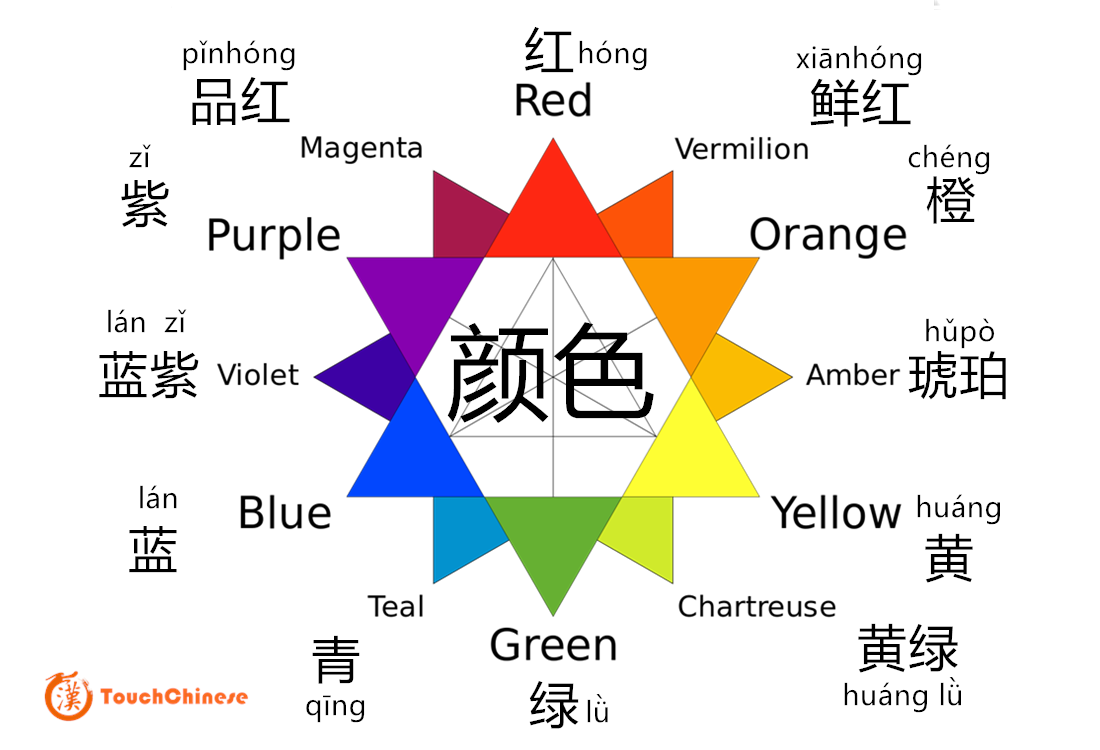It would be a dull world if all we could see was black, white, and gray, right? As a Chinese learner, you must have learned several words about colors even from HSK2. Well, let’s add more colors to your Chinese studies. Below are some of the most common “color” words in Chinese:
| Chinese | Pīnyīn | English |
| 白色 | báisè | white |
| 粉红 | fěnhóng | rosy, pale pink |
| 黑色 | hēisè | black |
| 红色 | hóngsè | red |
| 黄色 | huángsè | yellow |
| 灰色 | huīsè | gray |
| 金色 | jīnsè | golden |
| 蓝色 | lánsè | blue |
| 栗色 | lìsè | reddish brown, chestnut color |
| 绿色 | lǜsè | green |
| 青 | qīng | green (blue, black) |
| 银色 | yínsè | the grade of silver in coins |
| 紫色 | zǐsè | purple |
| 棕色 | zōngsè | brown |
| 五颜六色 | wǔyánliùsè | multi-colored |
Though these are some of the basic words of color, in China, people also use color to describe other words, which then becomes figurative in meaning. To know these words and expressions, you would have a deeper understanding of Chinese culture.
| Chinese | Pīnyīn | English |
| 白领 | báilǐng | white collar |
| 蓝领 | lánlǐng | blue collar |
| 淤青 | yūqīng | black and blue (bruise) |
| 黄牌 | huáng pái | yellow card |
| 红牌 | hóngpái | red card |
| 红红火火 | hónghónghuǒhuǒ | red red fire fire |
| 红包 | hóngbāo | red envelopes |
| 绿卡 | lǜkǎ | green card |
| 绿色食品 | lǜsè shípǐn | green food |
| 红绿灯 | hónglǜdēng | traffic light |
| 青衣 | qīngyī | qing colored costume |
| 青砖 | qīngzhuān | qing bricks |
| 青花瓷 | qīnghuā cí | qing pattern porcelain |

红 (hóng)
In ancient China, the color red gained its meaning from fire. Unlike many other countries where fire has long been regarded as a symbol of danger or destruction, fire is generally considered to be a good thing in China. The Chinese people have a saying, 红红火火 (hónghónghuǒhuǒ), meaning the life of someone expands, prospers, cracks, and rockets like red flame. Red is the symbol of prosperity and happiness. More importantly, it’s also the primary color for celebrations, especially the Lunar New Year and wedding ceremonies. During the Lunar New Year, elders give 红包(hóng bāo) or red envelopes to children. To wish them a “Happy New Year”, you can say:
送给你红包,祝你新的一年红红火火!
(Sòng gěi nǐ hóngbāo, zhù nǐ xīn de yìnián hónghónghuǒhuǒ!)
Give you red envelopes, I wish you a prosperous New Year!
Red, however, can also mean a warning. In a sports match, the referee can give you a 红牌 (hóngpái)or red card, which means you can’t participate in the game anymore. When you get a 黄牌 (huángpái) or yellow card, it means the referee has warned you about your behavior.
他已经拿到一个黄牌了,如果再犯规,就要拿红牌停止比赛了。
(Tā yǐjīng ná dào yí gè huángpái le,rúguǒ zài fànguī,jiùyào ná hóngpái tíngzhǐ bǐ sài le.)
He has already got a yellow card and if he fouls again, he will take a red card and have to stop playing.
绿 (lǜ)
In China, green means “clean” or “free of contaminants”. When people talk about “green technology” or “green energy”, they mean “sustainable” or “eco-friendly”. So when you go to buy food, you can suggest this to the shop assistant and say:
我们想要买绿色食品。
(Wǒmen xiǎngyào mǎi lǜsè shípǐn.)
We want to buy green food.
Green can also mean “go” or “to pass”.
过马路的时候注意安全,一定要看红绿灯。
(Guò mǎlù de shíhòu zhùyì ānquán, yídìng yào kàn hónglǜdēng.)
Pay attention to your safety when you cross the road. Be sure to look at the traffic lights.
他在美国工作五年,终于拿到了绿卡。
(Tā zài Měiguó gōngzuò wǔnián,zhōngyú ná dào le lǜkǎ.)
After five years of working in the United States, he finally got his green card.
青 (qīng)
青 (qīng) green (blue, black) is an interesting color that doesn’t appear in the standard set of colors commonly identified in western cultures. Technically, qing is a color that sits anywhere between blue and green, and should not be thought of as odd. 青is closely linked to historical buildings and clothing, like 青砖or qing bricks, and青花瓷or qing pattern porcelain. Also, there is a type of female character in Peking Opera called a “青衣 (qīng yī) or qing colored costume, because they usually wear costumes in this interesting color.
当你来中国游览的时候,一定要去看看青砖,青花瓷和青衣。
(Dāng nǐ lái Zhōngguó yóulǎn de shíhòu,yídìng yào qù kànkan qīngzhuān,qīnghuā cí hé qīngyī.)
When you visit China, be sure to see qing bricks, qing pattern porcelain, and qing colored costumes.
When a person’s skin turns blue or black from the impact of an external force, we call this 淤青(yū qīng)or a black and blue bruise.
我的膝盖淤青了。
(Wǒ de xīgài yūqīng le.)
My knee is bruised.
In addition, we also have the terms blue-collar and white-collar workers, just like in the west.
他过去是一个蓝领,通过自己的努力,现在是一个白领了。
(Tā guòqù shì yī gè lánlǐng, tōngguò zìjǐ de nǔlì, xiànzài shì yī gè báilǐng le.)
He used to be a blue-collar worker, but now he is a white-collar worker through his own efforts.
Life is certainly more fun if it is more colorful. Learn these Chinese words of color and use them in your conversations for a more colorful way of expressing yourself.

